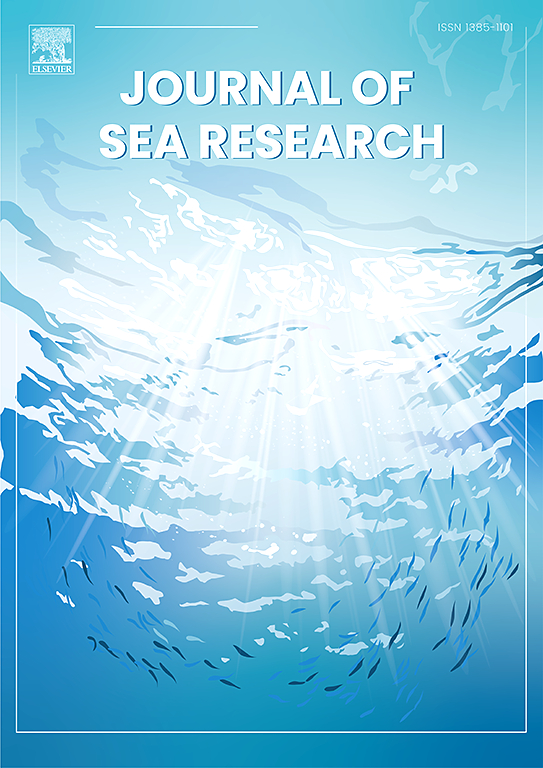Bioenrichment of potentially toxic elements in fishes and shrimps of Sepetiba Bay (RJ, SE Brazil)
IF 2.9
4区 地球科学
Q2 MARINE & FRESHWATER BIOLOGY
引用次数: 0
Abstract
The main objectives of this study are to analyze the presence of potentially toxic chemical elements (PTEs) in fish and shrimp from Sepetiba Bay (coastal region of the State of Rio de Janeiro, SE Brazil), compared to results obtained in previous studies and to discuss the risks of consuming contaminated food for humans. Sepetiba Bay is a coastal system heavily contaminated by PTEs. Concentrations of As, Cd, Co, Cr, Cu, Ni, Pb, Se, and Zn were analyzed in tissues and organs of crustaceans (shrimp, Farfantepenaeus subtilis) and bony fishes (Cynoscion leiarchus, Cynoscion acoupa, Centropomus undecimalis, Plagioscion squamosissimus, Selene setapinnis, and Caranx hippos) using an Inductively Coupled Plasma Optical Emission Spectrometer (ICP-OES). Copper was the element that reached the highest levels among the analyzed species/tissues/organs, followed by Zn > Se > As>Cd > Pb > Cr > Ni > Co. Still, Zn, Cu, and Cr were present in all analyzed samples. For most species, the organs with the highest levels of PTEs were the heart and liver. The statistical results showed positive and significant correlations between the PTE concentrations of the analyzed species/tissues/organs. The Bioenrichment Factors (BF: the ratio between the levels of PTEs in the analyzed tissues/organs and the limits defined by the regulatory agencies) show that there are higher levels of PTEs than those allowed by law in the analyzed species/tissues/organs (descending order number of times higher): Cr (71), Se (35), Pb (32), Cu (23), As (13), Cd (10), Zn (7), and Co (5). For example, Cr showed relatively high BF values: C. acoupa (heart: 70 times; gills 9 times), C. undecimalis (heart 17 times), C. leiarchus (gills 13 times; heart 11 times; liver 9 times); gonads 8 times), C. undecimalis (gills 12 times), P. squamosissimus (gills 10 times) and F. subtilis (cephalothorax 9 times; carapace 7 times; muscle 7 times). The heart of S. setapinnis (35 times), the liver of P. squamosissimus (23 times), and the muscle of F. subtilis (4 times) showed Se enrichment higher than the amount authorized by Brazilian legislation (Anvisa). The gills of P. squamosissimus (32 times) and the gonads of C. leiarchus (5 times) and C. acoupa (4 times) indicated considerable bioaccumulation values for Pb enrichment, above the FAO/WHO (Food and Agriculture Organization/World Health Organization) limit. Therefore, this study shows a potential risk of metal contamination in the population that eats fish in the Sepetiba region. Fish is part of the traditional diet of the population living around Sepetiba Bay, primarily among low-income families who dominate the area. The results of this study suggest the need to monitor seafood contamination in this region.
巴西东南部Sepetiba湾鱼虾体内潜在有毒元素的生物富集
本研究的主要目的是分析来自Sepetiba湾(巴西东南部里约热内卢州沿海地区)的鱼和虾中潜在有毒化学元素(pte)的存在,并与以前的研究结果进行比较,并讨论食用受污染食物对人类的风险。Sepetiba湾是一个被pte严重污染的海岸系统。利用电感耦合等离子体发射光谱仪(ICP-OES)分析了甲壳类动物(对虾、Farfantepenaeus subtilis)和硬骨鱼类(Cynoscion leiarchus、Cynoscion acoupa、Centropomus undecimalis、Plagioscion squamossimus、Selene setapinnis和Caranx hippos)组织器官中As、Cd、Co、Cr、Cu、Ni、Pb、Se和Zn的含量。在被分析的物种/组织/器官中,铜的含量最高,其次是Zn和gt;Se祝辞As> Cd比;Pb祝辞Cr祝辞倪祝辞然而,在所有的分析样品中都存在Zn、Cu和Cr。对于大多数物种来说,pte水平最高的器官是心脏和肝脏。统计结果显示,被分析物种/组织/器官的PTE浓度之间存在显著正相关。生物富集因子(BF:被分析物种/组织/器官中pte含量与监管机构规定的限值之比)表明,被分析物种/组织/器官中pte含量高于法定水平(高的倍数由高到低):Cr(71)、Se(35)、Pb(32)、Cu(23)、As(13)、Cd(10)、Zn(7)和Co(5)。例如,Cr表现出较高的BF值:C. coupa(心脏:70倍;鳃9次),心(17次),利阿克(13次);心11倍;肝脏9次);性腺8次)、褐毛棘球绦虫(鳃12次)、鳞棘球绦虫(鳃10次)、枯草棘球绦虫(头胸9次);甲壳7倍;肌肉7次)。sesetapinnis的心脏(35倍)、P. squamosissimus的肝脏(23倍)和F. subtilis的肌肉(4倍)的硒富集量均高于巴西立法(Anvisa)的规定。鳞棘棘鱼的鳃(32次)、leiarchus的生殖腺(5次)和acoupa的生殖腺(4次)显示出相当大的富集Pb的生物积累价值,超过了FAO/WHO(联合国粮食及农业组织/世界卫生组织)的限量。因此,这项研究表明,在Sepetiba地区吃鱼的人群中存在潜在的金属污染风险。鱼是Sepetiba湾附近居民传统饮食的一部分,主要是居住在该地区的低收入家庭。本研究结果提示有必要对该地区的海产品污染进行监测。
本文章由计算机程序翻译,如有差异,请以英文原文为准。
求助全文
约1分钟内获得全文
求助全文
来源期刊

Journal of Sea Research
地学-海洋学
CiteScore
3.20
自引率
5.00%
发文量
86
审稿时长
6-12 weeks
期刊介绍:
The Journal of Sea Research is an international and multidisciplinary periodical on marine research, with an emphasis on the functioning of marine ecosystems in coastal and shelf seas, including intertidal, estuarine and brackish environments. As several subdisciplines add to this aim, manuscripts are welcome from the fields of marine biology, marine chemistry, marine sedimentology and physical oceanography, provided they add to the understanding of ecosystem processes.
 求助内容:
求助内容: 应助结果提醒方式:
应助结果提醒方式:


